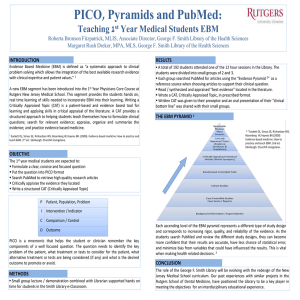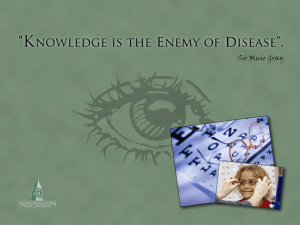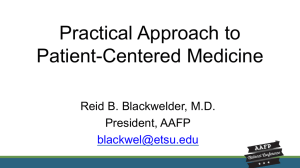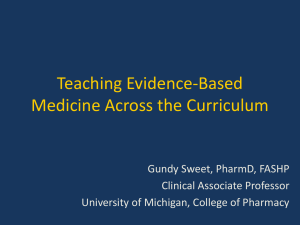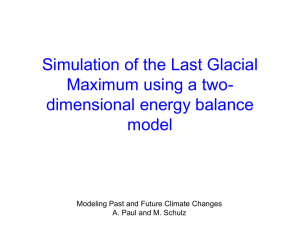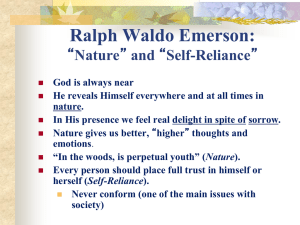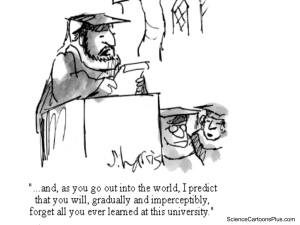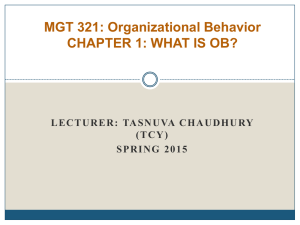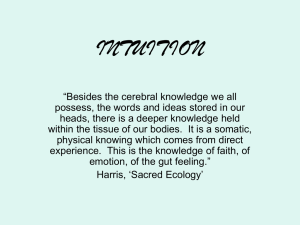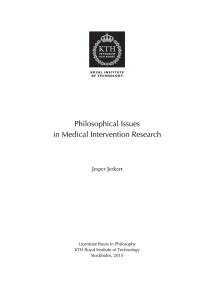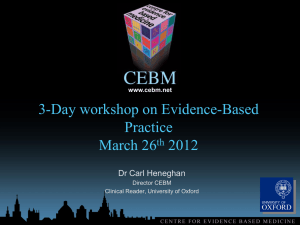A Comprehensive Model of Voice Therapy
advertisement
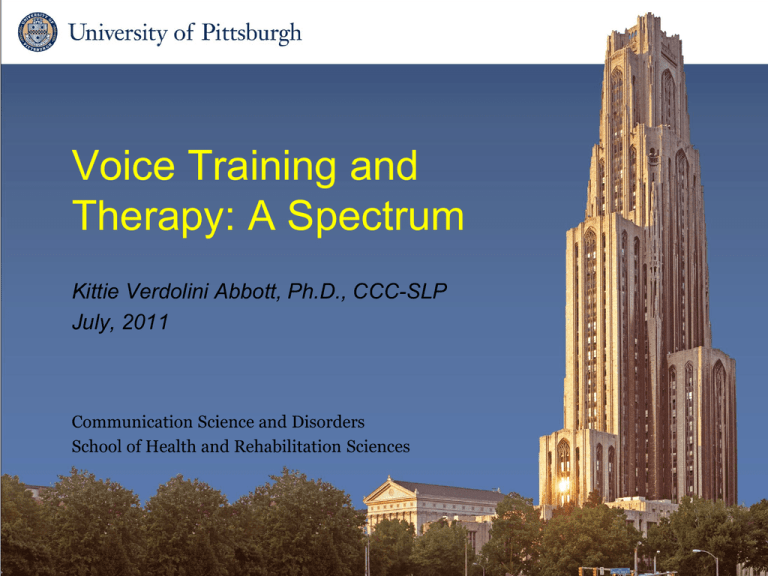
Voice Training and Therapy: A Spectrum Kittie Verdolini Abbott, Ph.D., CCC-SLP July, 2011 Communication Science and Disorders School of Health and Rehabilitation Sciences Context • Historical – Voice therapy using a series of “facilitating techniques” (e.g., Boone) – Distinctive advance at time of introduction; first systematic assembly of wide range of voice therapy techniques, rationale, and case examples internet-d.com Context • Concern – Voice therapy approaches based on trial and error – Approaches lacked cohesive theoretical framework – Approaches lacked empirical data (difficult to research due to idiosyncratic nature of combining “techniques” ) bananabelt.org Next generation • “Packaged” therapies – Lee Silverman Voice Treatment (Ramig) – Vocal Function Exercises (Stemple) – Laryngeal massage (Roy) – Lessac-Madsen Resonant Voice Therapy (Verdolini) – Accent Method (Smith et al.) amassblog.com Next generation • Advantages – Cohesive frameworks – Systematic programs allowing for (a) formal clinician training; (b) scrutiny by evidencebased medicine shebamuturi.wordpress.com Next generation • Concerns – Nearly evangelical enthusiasm for some programs cnimf.org Next generation • Concerns • Tendency towards “cookbook” orientation Next generation • Concerns – Questions about “evidence-based medicine” (warning: next slides, minor tirade) • Qualifier – EBM is a generally a good thing, overall – I make a living doing EBM – I know how to do EBM – I simply voice some cautionary concerns meant to “temporize” broadstreetbuzz.com Stated differently • New type of authority – Many clinicians seemed as robotic about the new master (EBM) as we did about the old one (“expert opinion”). – We need to evaluate the concept and practice of “EBM” judiciously. Evidence-based medicine • “The dark side” • (Term coined by Eva van Leer) alum.wpi.edu What’s the problem??? • The issue seems innocent enough. • Pi picasaweb.google.com • EBM defined as “The conscientious, explicit and judicious use of current best evidence in making decisions about the care of individual patients. The practice of evidence-based medicine means integrating individual clinical experience with the best available external clinical evidence from systematic research.” Sackett et al. BMJ. 1996;312:71-72. bu.edu Best research evidence aspiruslibrary.org EBM P1(RCT) • RCTs and RCT meta-analysis as “best evidence” (why???) • Reveal average results for average patient; what about your patient??? • Success of randomization depends on the law of (really) large numbers (think insurance companies), which we never have in SLP trials education.com EBM P1(RCT) • I.e., there are concerns about deductive reasoning – Deductive reasoning goes from population to individual – Works well for actuarial purposes (“average” result; relevant for insurance companies) but not necessarily so well for your individual patients • Casuistic reasoning is at least as defensible for clinical practice – Reasoning by analogy (e.g., similar cases) – Can be rigorous • Tonelli, 1998; see also Samarkos, 2006 EBM P2 (Role of “evidence”) • “Evidence” crowds out experience, values, and resources in the model • Proponents of EBM remind us that experience, values, and resources are in the model. http://www.flickr.com/photos/jamescridland/613445810/ EBM P2 (Role of “evidence”) • Then why is it still called “evidencebased medicine???” EBM P3 (Philosophy of science) • Philosophy of science – Basic assumption in science is the future will act like the past (e.g., David Hume; John Cobb) • Fundamental fallacy – Future conditions are never identical to past conditions – Even if conditions were identical, stochasticity (randomness) determines different results EBM P3 (Philosophy of science) • So are there basic philosophical cautions about what evidence from the past can tell us about our patient in the future? • Ha hammertap.com EBM P4 (Reality of nature) • Moreover, human health is much more complex than typically implied by linear models in most EBM: – y = mx + b (linear) • Complexity – Non-linearity – Variability – Stochasticity (random element) • E.g. Li et al., 2009; EBM P4 (Reality of nature) faculty.uca.edu m arkettechnologies.com EBM P5 (Epistemology) • Epistemology – How do we come to “know” things? – Only standing “outside the problem” as with “evidence,” or also standing “inside the problem” (explanation follows)? EBM P6 (Evidence itself!) • There is no evidence that evidence-based medicine improves clinical outcomes! naturalhealthcarereviews.com Possible solutions • Evidence: Expand the scope of type of “evidence” we use, beyond RCTs • Beyond evidence: Reclaim – First principles – Intuition and creativity simple.wikipedia.org Possible solutions: Expanding scope of “evidence” • SS evidence: Casuistic reasoning (reasoning by analogy, including analogy with other patients of yours, i.e., “in my hands” evidence) (Tonelli, 1998; see also Samarkos, 2006) totallylookslike.icanhascheezburger.com; I’m sparing you the George W. Bush look-alike Possible solutions: Beyond “evidence” • The principle of “first principles” – Many first principles don’t need clinical “evidence” about their clinical utility, and can be used flexibly – E.g., parachute study greenstandardstrust.wordpress.com moonfrye.ning.com Parachute study Int J Prosthodont. 2006 Mar-Apr;19(2):126-8. Parachute use to prevent death and major trauma related to gravitational challenge: systematic review of randomised controlled trials. Smith GC, Pell JP. Source Department of Obstetrics and Gynaecology, Cambridge University, United Kingdom. gcss2@cam.ac.uk Abstract OBJECTIVES: To determine whether parachutes are effective in preventing major trauma related to gravitational challenge. Design Systematic review of randomised controlled trials. DATA SOURCES: Medline, Web of Science, Embase, and the Cochrane Library databases; appropriate internet sites and citation lists. STUDY SELECTION: Studies showing the effects of using a parachute during free fall. MAIN OUTCOME MEASURE: Death or major trauma, defined as an injury severity score > 15. RESULTS: We were unable to identify any randomised controlled trials of parachute intervention. CONCLUSIONS: As with many interventions intended to prevent ill health, the effectiveness of parachutes has not been subjected to rigorous evaluation by using randomised controlled trials. Advocates of evidence based medicine have criticised the adoption of interventions evaluated by using only observational data. We think that everyone might benefit if the most radical protagonists of evidence based medicine organised and participated in a double blind, randomised, placebo controlled, crossover trial of the parachute. Beyond “evidence” • First principles: To a great extent, this course is about first principles we can use to flexibly create individualized voice therapy (with examples in packaged “templates”). Possible solutions: The case for intuition and creativity • Reclaiming intuition and creativity – First step is being fully present (to capture cues we miss when we’re “in our heads”) inspiration-for-singles.com Possible solutions: The case for intuition and creativity • Reclaiming intuition and creativity – Potential reliance on mirror neurons to solve clinical challenges creatively in the moment (e.g., Rizzolatti & Craighero, 2004) – Potential reliance on nonconscious “data base” we have accumulated clinically, allowing for “intuitive pattern detection (e.g., master chess players; Kahneman v. Klein, 2009) slog.thestranger.com Possible solutions: The case for intuition and creativity • Reclaiming intuition and creativity – To a great extent, this course is also about reclaiming intuition and creativity as partially valid foundations for principled individualized voice therapy (examples of therapies shown in “packaged” LMRVT and CBCFT, but we will go beyond). seotipss.com Purposes of course • Provide overview of critical “building blocks” (first principles) for voice tx • Examine existing packaged therapies for their relation to identified first principles. dandelionsummers.com Train two tx “packages” that are examples of how the building blocks may be assembled (LMRVT and CBCFT), and associated outcome data. Demonstrate how intuition and creativity can be used in a principled, systematic way “in the moment” to create individualized voice therapy (IPTIM). Real agenda • For you to acquire fundamental building blocks in how to construct personalized voice therapy. • For you to reclaim for yourself the dignity of intuition and creativity in the therapy process. encore.sla.org Arthur Lessac (LMRVT) Mark Madsen (LMRVT) Janina Casper (CBCFT) atsosxdev.doit.wisc.edu Jackie Gartner-Schmidt (CBCFT) Aside • Vocal abuse/misuse: We’ve gotten rid of these terms, right? – – – – Circular Poorly defined Indistinct Potentially negative for therapy outcome (by way of self-efficacy and compliance; Bandura, 1977) • Verdolini, 1999 Basic building blocks • Three parameters are necessary and sufficient to address in voice therapy – Physiology (biomechanics, biology): “What?” – Learning: “How?” – Compliance: “If?” science-art.com General proposal • Knowledge regarding the three parameters – Is distinct – Is desirable to optimize likelihood of therapy success en.wikipedia.org Structure of seminar • Basic science (“building blocks”) – Biomechanics/biology – Motor learning – Patient compliance • “Evidence:” RCTs • Applications – Step by step details and practice with LMRVT and CBCFT – Demonstrations and practice – Intro to “IPTIM” “individualized principled therapy in the moment” (aka “unscared therapy;” intuition and creativity)
